The Path to Marriage Equality in GCN: Part 2 Commentary from Tomboktu
6th June 2016
To mark the anniversary of the marriage equality referendum, The Irish Left Archive is publishing a short series of articles on the evolution of discussion of same-sex couples, lgb families, and their legal recognition, as portrayed in the pages of Gay Community News in the 1990s. The first in this series covered the years 1990 to 1994; here we continue the story with material from 1995 and 1996. The articles are from my collection of GCN issues from the 1990s. (My collection is incomplete, and important developments may not be included because of that.)
The first piece is from the April 1995 issue, and it is a short review of John Boswell’s The Marriage of Likeness: Same-Sex Unions in Pre-Modern Europe, which is an atypically scholarly book to make the review section of GCN. However, as the review itself explains, this particular book had ‘broken out’ of academia and had garnered attention in Newsweek. I notice, but don’t know what significance to attach to, the fact that the reference in the article to ‘same-sex “marriages”‘ places inverted commas around the word marriage.
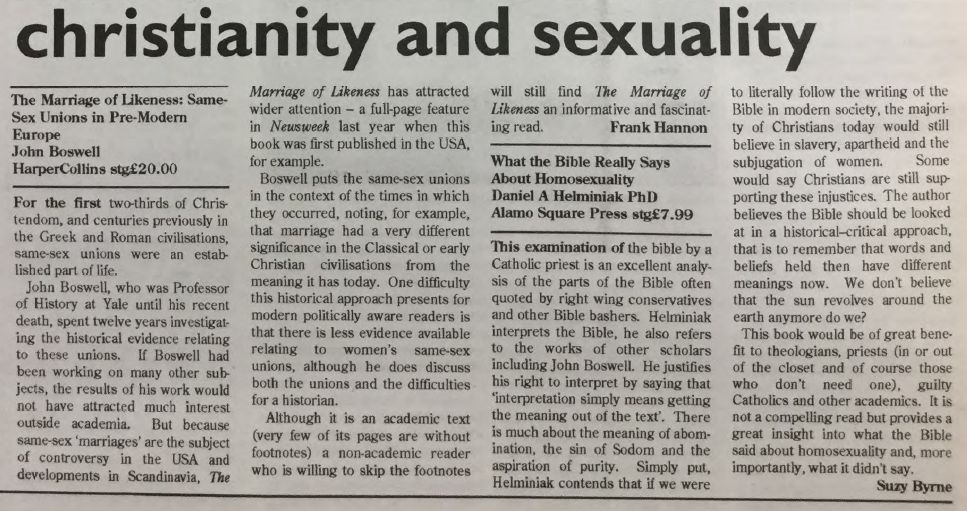
A month later, in the May 1995 issue, GCN reports on two significant developments. In the first, the legal status of same-sex partners is the lead story in GCN for the first time. The headline, opaquely, reports a call from the ‘CSW’ — the Council for the Status of Women, now the National Women’s Council of Ireland — for same-sex partnerships to be recognised (or ‘recognized’ as GCN put it). The headline focuses on the fact that the Council made the call, but article itself explains that a member organisation called LEN — the Lesbian Equality Network — had put down a motion at the Council’s annual general meeting the previous month.
Whatever about the quality of the headline writing, this has be a landmark event.
It is interesting to note that GCN reported this call as ‘equality’ even though the Council did not call for marriage to be opened to same-sex couples. The article also shows that the question of registered partnerships had been raised with officials in the Department of Equality and Law Reform, but that officials had rejected a call to include provision for recognition of same-sex couples would need a constitutional amendment.
I think two other details in the coverage GCN gave to the event are interesting: (a) the LEN speaker at the AGM of the Council for the Status of Women chose to be anonymous; (b) support at the meeting came from Gráinne Healy of Women in Learning, and she is the subject of the front-page photograph in GCN. Two decades later she was to become one of three co-chairs of Yes Equality, in her capacity as leader of Marriage Equality.
The second report is a call from the Labour Party for the planned equality legislation to include legal recognition for same-sex couples in the form of registered partnerships. In my opinion, the call by the Labour Party was a much bigger development than the call by the women’s council: it seems to be the first time a mainstream political party — indeed, a government party at the time — called for same-sex couples to have legal recognition in Ireland, but GCN‘s report is very short and placed on page 3. The details provided in the story are limited. One speaker at the Labour conference, Suzy Byrne, is briefly quoted. She had been an activist with GLEN, the Gay and Lesbian Equality Network, but she is not identified as speaking for GLEN, and the paper does not contain any response to the Labour party’s new policy from any of the lgb organisations.
The limited space given to the Labour Party’s decision might have been explained if GCN received the news very shortly before it went to print, but it seems to me now that such a significant development would have merited more in-depth reporting the following month — with reactions from GLEN or LEN, for example, or a statement from the Department of Equality and Law Reform which was headed by a Labour minister and preparing the legislation the Labour notion identified as the vehicle for the reform. However, the June issue is silent.
I wonder if this oddly muted reporting is something that a proper historian could today probe more thoroughly: What was the wording of the motion at the Labour conference? Was the decision reported in any of the national newspapers? Do departmental papers show if the Labour minister in the Department of Equality and Law Reform acted on the motion when he got back to his department after the conference?
Whatever the answers to those questions are, the limited coverage given by GCN is a puzzle.
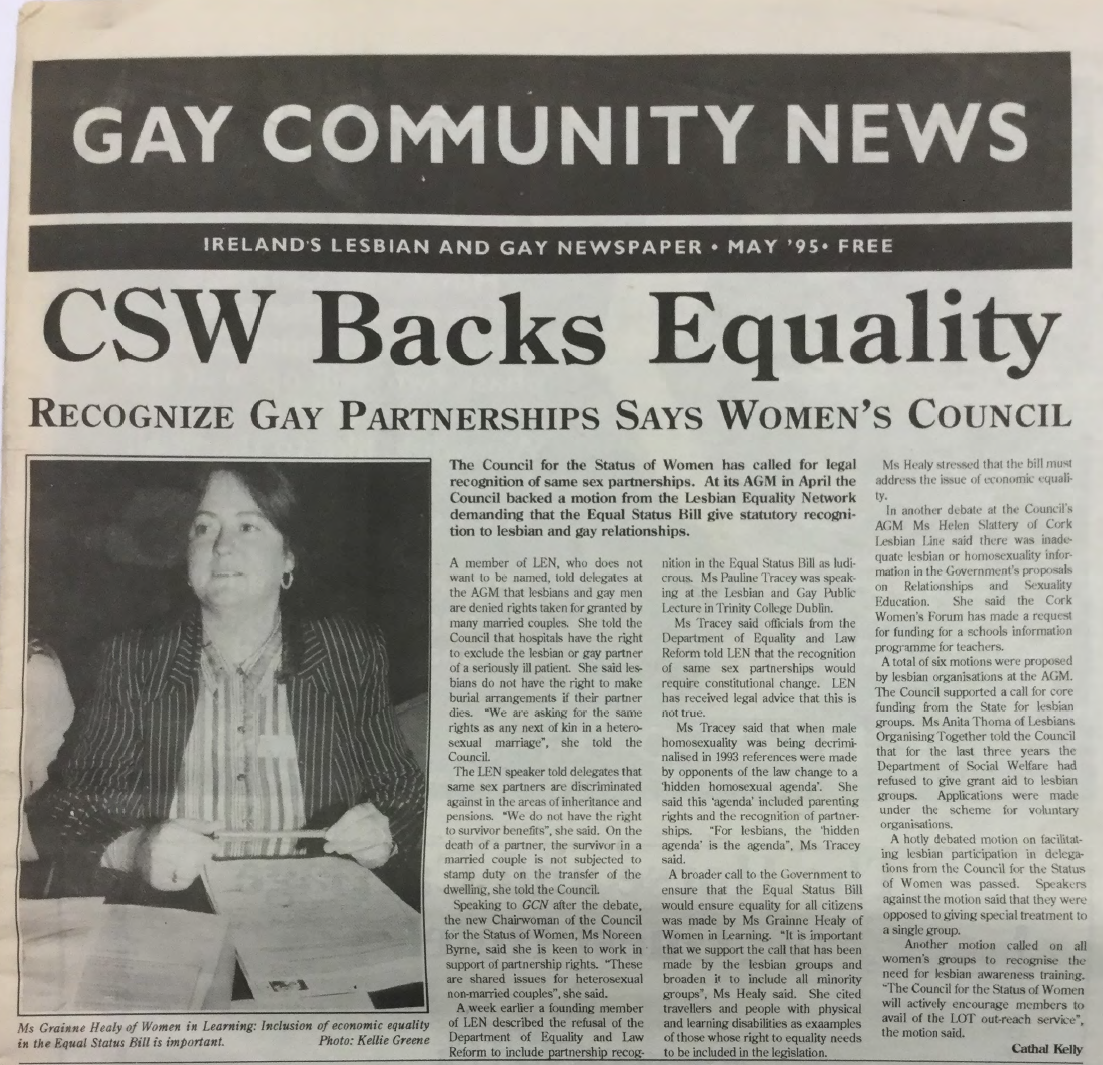
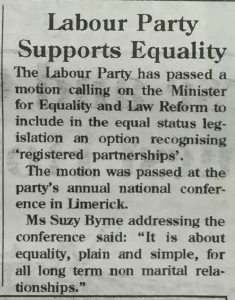
Although GCN did not follow-up on the Labour party’s new policy in its June issue, it did publish a full-page feature on gay families, in particular the experience of gay fathers. The article centred around an interview with Brian, an Irish gay man and his relationship with his five-year-old son, Colum. Brian has regular access to Colum, but says that he and his partner do not show affection in front of Colum because Colum attends a small rural school:
When he’s older it’ll be different, when he’s able to keep his mouth shut about it, but I don’t want to cause any problems for him
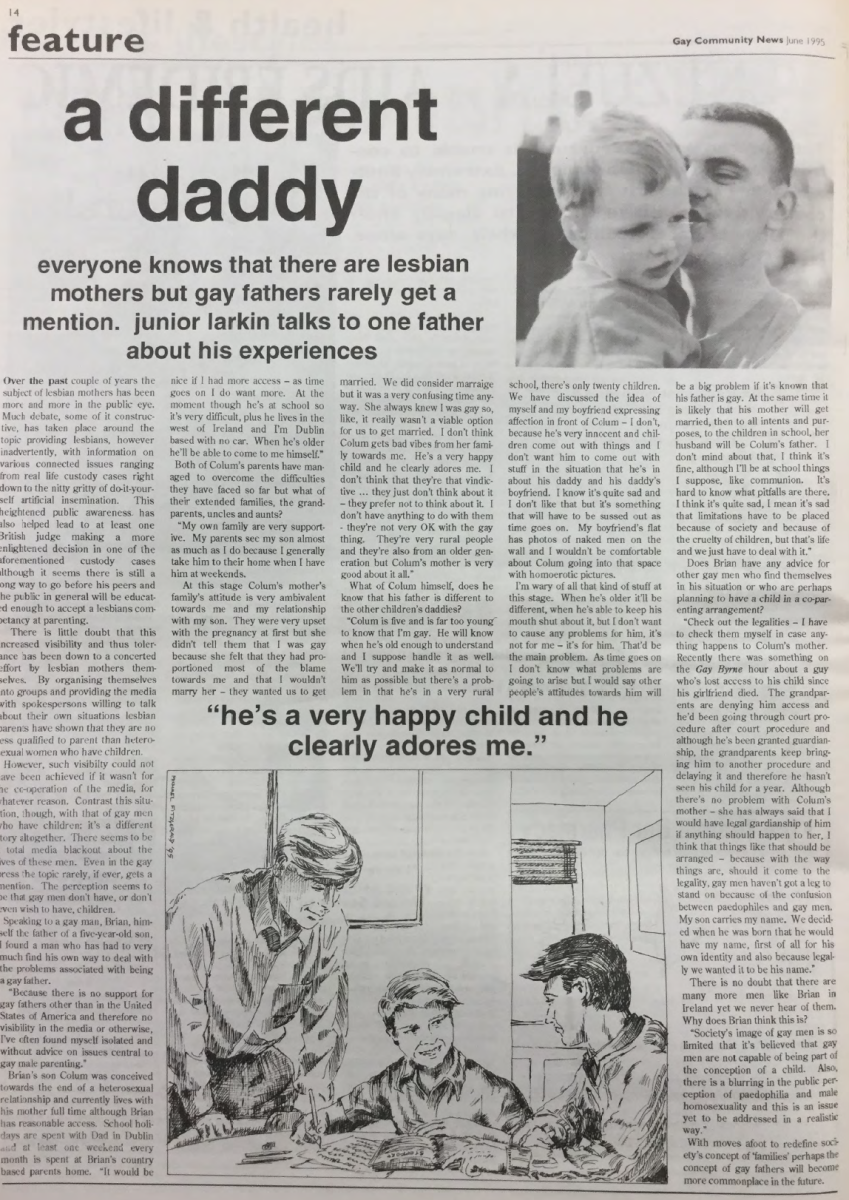
Two months later, in August 1995, we have the first report in GCN of GLEN speaking about partnership rights for same-sex couples. The event was the publication of the Domestic Violence Bill 1995. The Bill proposed to give people living together protection from domestic violence. This is described in the article as ‘recognition of lesbian and gay partnerships’ and the co-chair of GLEN said the proposal was ‘epoch-making’. Here, I break with my pattern of noting items from GCN in the sequence in which they were published to alert you to the fact that early the following year, when the bill became law, GCN reported that LEN — the Lesbian Equality Network — disagreed with GLEN’s statement that the Domestic Violence legislation constituted recognition of lesbian and gay partnerships.

A month later, in September, and it seems safe to say that lgb families have definitely become a subject of ‘official’ discussion in the Irish lgb community and press, even if the law does not provide recognition or protection yet. That issue of GCN contains a feature article on commitment ceremonies. The article also notes a new form of disagreement in the lgb community:
Of course, some lesbians and gays are dead set against the idea of marriage, seeing it as a heterosexual institution and therefore not for them
(I’ll be naughty and add a comment that is not drawn from the pages of GCN: My memory of the views at the time was that those who opposed marriage did so not because it was a heterosexual institution but because it was a patriarchal one.)
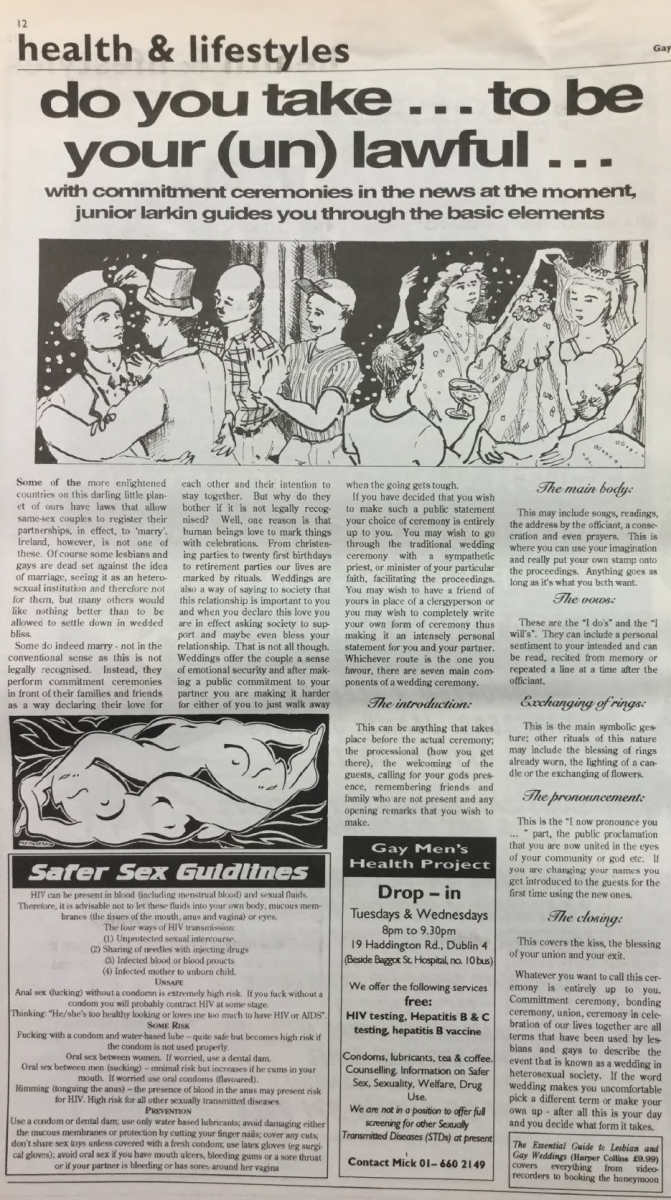
Two other articles in the September issue report developments in the work to secure legal recognition for same-sex couples. On the news pages, a short item carries reports about two submissions to the Constitution Review Group. Both the Labour Party and GLEN made submissions calling for the equality article in the Constitution to be amended to include ‘sexual orientation’, but of particular interest to us here is the final paragraph in GCN‘s story. That records that GLEN also called for the article in the Constitution ‘dealing with the family to be revised to reflect the diversity of personal relationships which now exist in Ireland’. It would be interesting to know if that phrase in the GCN report is taken from GLEN’s submission or is GCN‘s summary of what was in the submission.
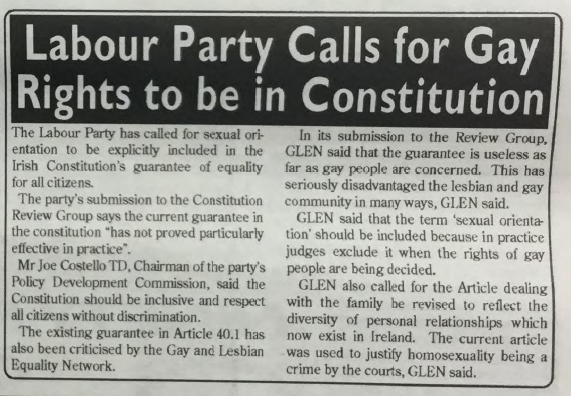
The other target of the lobbying that GCN covers in the September issue is the United Nations. Page 5 contains two articles on the same page about the preparations by Irish lesbian groups for the Fourth UN Women’s conference in Beijing, and in the fourth column we see that LOT, Lesbians Organising Together, demanded legislation to protect lesbians from discrimination in, among other areas, partnership, custody and parenting.
This is the first time (at least in my collection) that we see a reference to parenting and custody in the context of law reform and same-sex couples. And that’s it: Those topics are named and we move on.
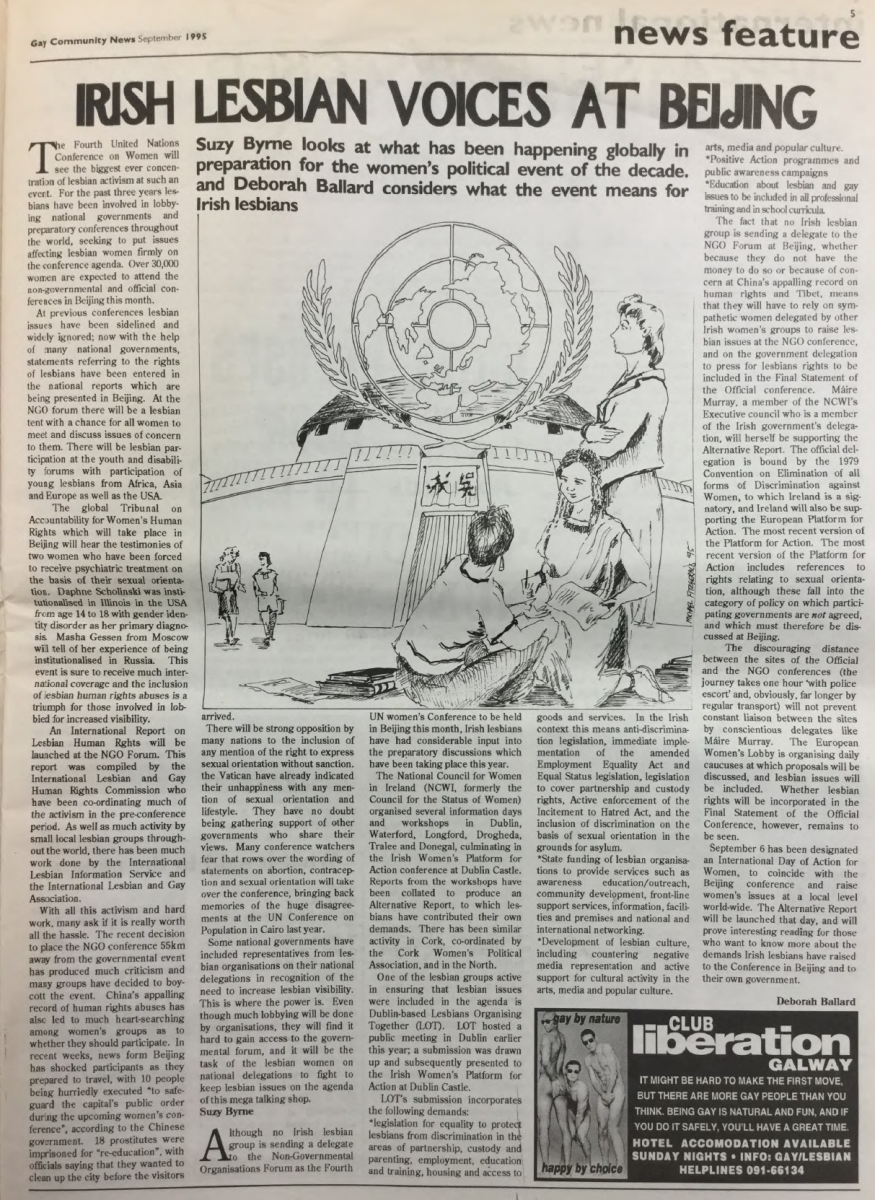
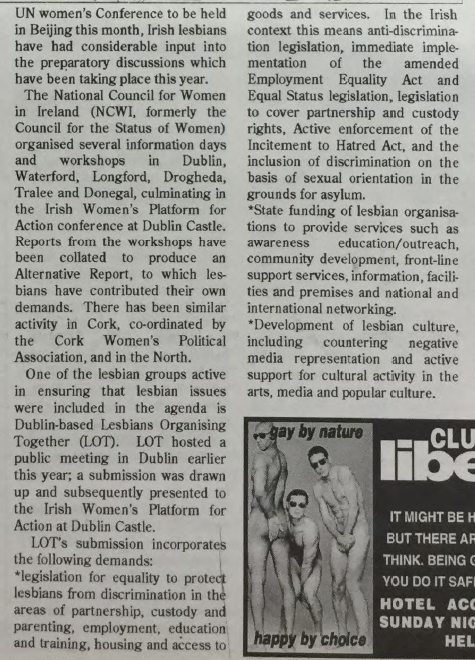
The last two cuttings from 1995 contain three articles published in the November issue. The first cutting is of two short international news reports from Denmark and Canada. The Danish report concerned a gay man and a lesbian who married each other as a protest against the ban in Danish law on gay couples having children through adoption or donor-assisted reproduction. The Canadian story is about a legal challenge by a trade union against a court ruling that prevented lgb people receiving benefits for their partners.
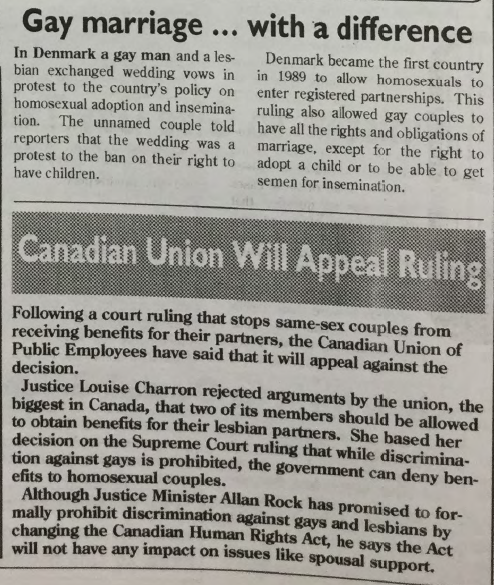
The final article in 1995 — the thrid from the November issue — is a poignant article written by Mary Stephens, a lesbian in her sixties, whose partner had died suddenly, in her sleep. Stephens writes about the shock of her partner’s death and about how she limits how much she shares with her supportive neighbours. She describes how later, when she tries to move on and make new lesbian friends, that while she does make friends, it is limited to a ‘comradely sort’ and that the one person with whom she might open a new intimate relationship lives too far way for that to work.
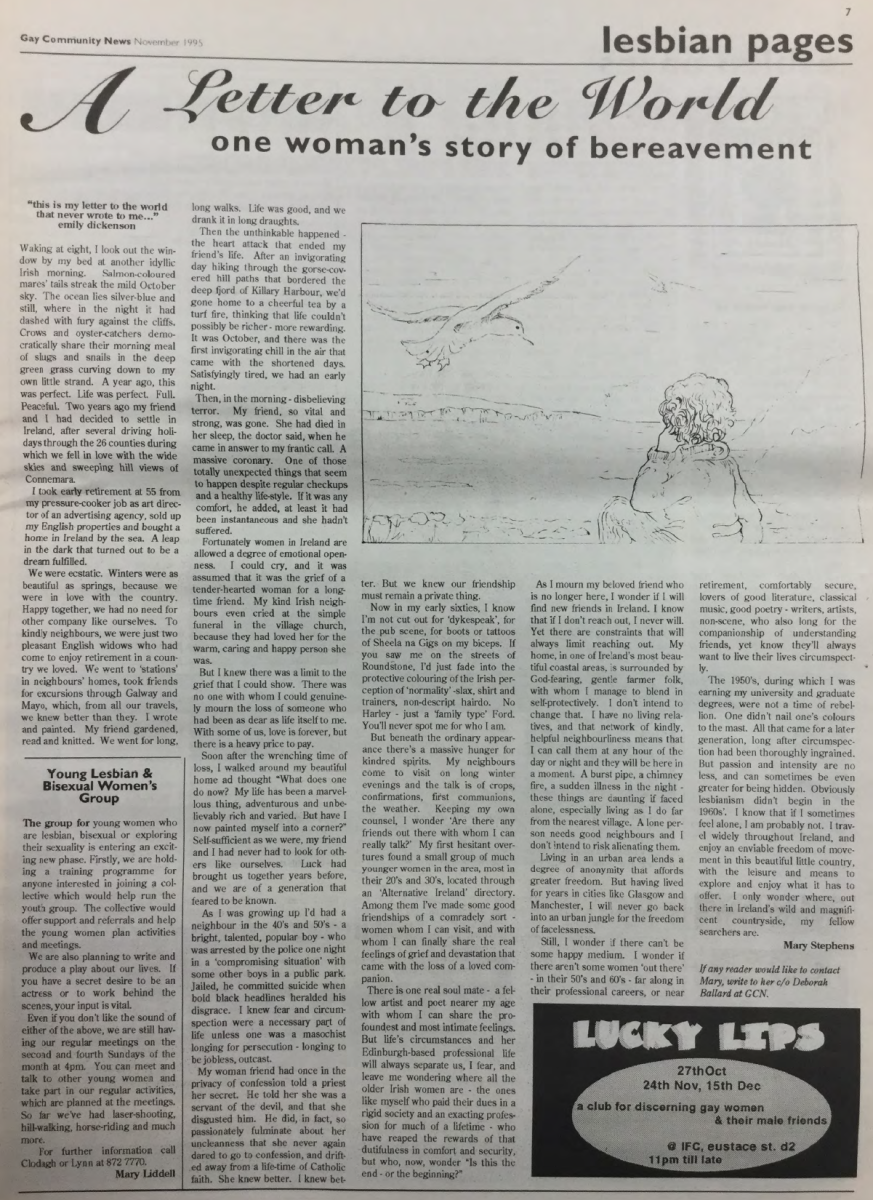
Homosexuality was decriminalised in 1993, and less than three years later, in February 1996, GCN published a letter from somebody doing a study of lesbian and fay families in Ireland.
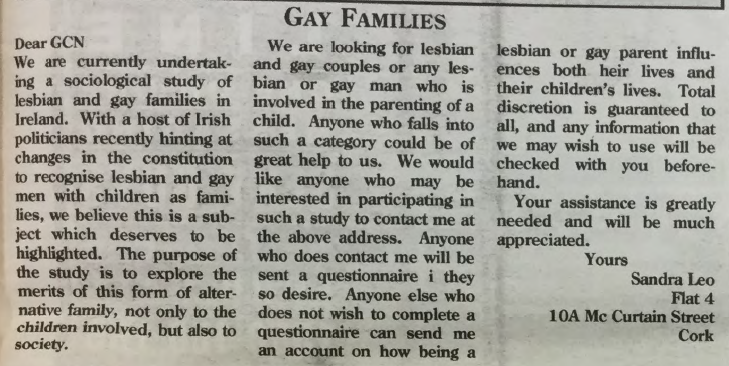
The February 1996 issue also contained a short report from GLEN’s annual open meeting. That report refers to three areas of law that GLEN worked on in 1995. One is GLEN’s submission on the ‘Violence Bill’ — clearly a truncated reference to the Domestic Violence Bill that had been welcomed by GLEN in August 1995 as giving legal recognition to lesbian and gay couples. A second is the Powers of Attorney Bill, which is reported as providing for ‘recognition of non-marriage and non-family relationships’. The area of law in the third item is not named, but it doesn’t need to be because a request to the Minister for Finance to ‘address the disadvantages that non-marital relationships experience’ is clearly about tax laws, though whether it is income tax, inheritance tax, or some other tax is not explained.
If there was any doubt before now, this article makes clear that there is a difference — though not necessarily that there is disagreement — between lgb lobby groups on how the law should recognise same-sex couples. The lesbian groups, LOT and LEN, were demanding registered partnerships, naming parenting rights, and seeking and many of the rights of married couples, while GLEN framed its pitch in terms of protecting the rights of people in diverse relationships and in non-martial or non-family relationships.
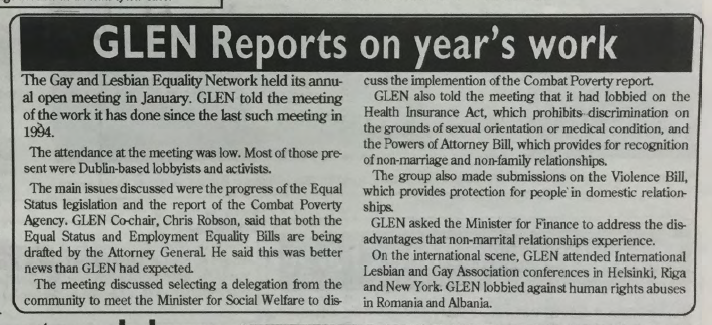
Two months later, GCN published the first of two articles which were to show that disagreement underpinned the differences in approach, although that was not apparent until te second article appeared a month later. In April 1996, the paper’s lead news story was the passing of Domestic Violence Act, under the headline “For the First Time” and with the subhead “Gay partnerships recognised for first time under Irish law”.
Chris Robson of GLEN said that the organisation was not looking for formal registration of lesbian and gay partnerships as is the case in Scandinavian countries. He said the group is lobbying for people in lesbian and gay partnerships to have the same rights as people in heterosexual relationships. Proposals from GLEN to have the tax laws reformed in this way were not implemented in the budget.
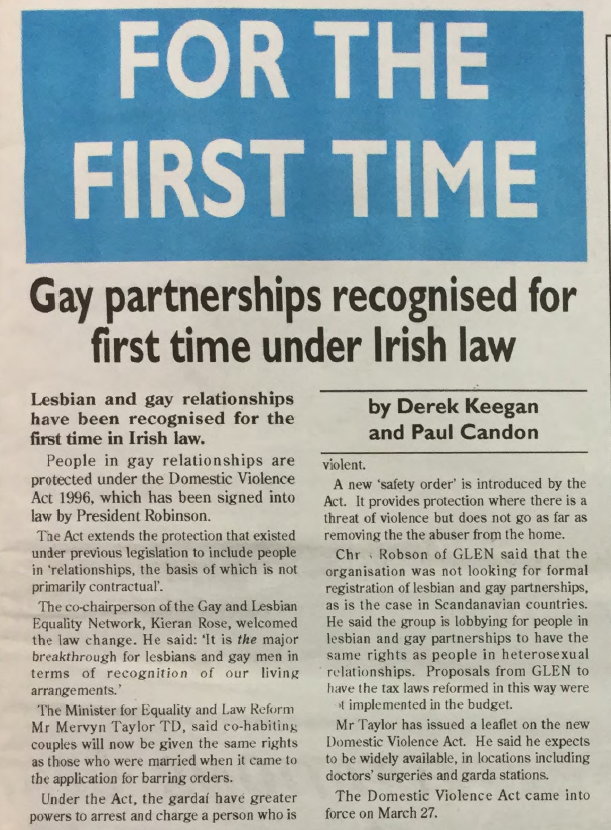
The following month, in May 1996, GCN reported that LEN criticised the Domestic Violence Act as discriminatory. The paper reports that it checked with a family lawyer to confirm LEN’s claim that the Domestic Violence Act placed gay lesbian and gay couples a different category from heterosexual couples, and with a lower standard of protection. The article reports, however, that GLEN held firm to its view that the Domestic Violence Act recognised lesbian and gay partnerships for the first time.
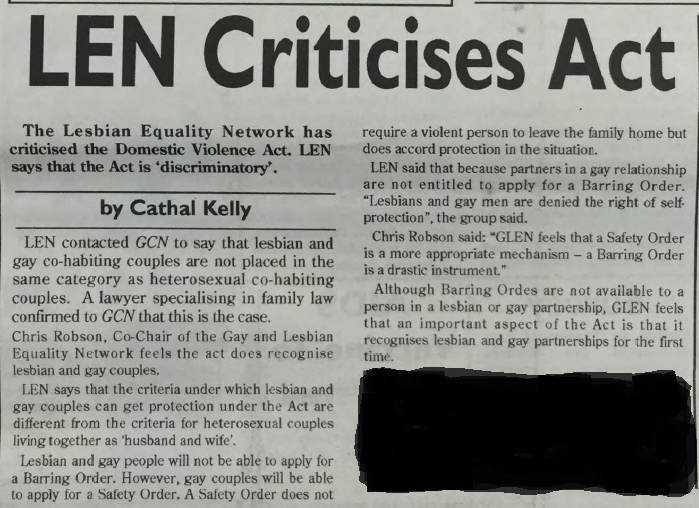
The final article in 1996 in my collection is a wide-ranging article containing a mix of opinion and in-depth reporting on developments in marriage and same-sex couples which was published in the June issue of GCN. The writer framed his article by noting that the Irish people had voted the previous November to amend the Constitution to allow for divorce, although at the time the article was written, the Fianna Fáil senator Des Hanafin had taken a legal challenge to prevent the amendment being implemented. A legal case in Hawaii had opened the prospect of same-sex marriage becoming legal in the USA, and the Dutch parliament had voted in favour of extending marriage to same-sex couples. Buried in the article is the first report of an elected Irish politician, Patricia McKenna MEP, of the Green Party, calling for marriage. Specifically, she is reported as calling on the Irish government to follow the Dutch example. And a third political party (that is, after Labour and the Greens), is reported as supporting equality for same-sex couple. Eoin Ó Broin, then chairperson of Sinn Féin’s Gay, Lesbian and Bisexual Working Group (and now a TD) said his party would ‘campaign for the introduction of a domestic partnership bill which would lead to full equality and absolutely no distinction between homosexual couples and heterosexual couples under the law’.
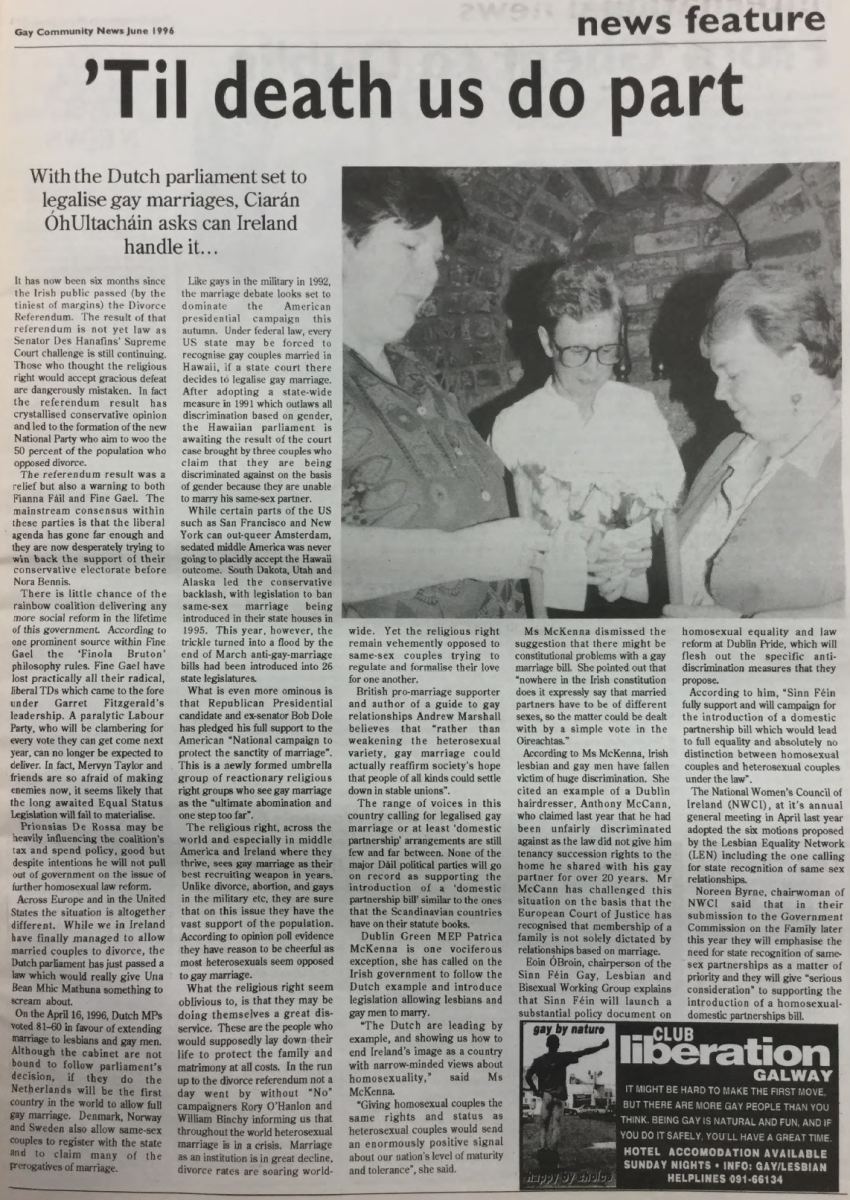
We can see that 1995 and 1996 were busy years. We saw the first calls by lgb organisations and some politicians for legal recognition of same-sex couples. GCN‘s reporting establishes that the differences between lgb organisations were grounded in disagreements on the objectives to be achieved. And developments in other countries were being noticed in Ireland. In the final post in this series, in a few weeks, I will explore what GCN had to say for the rest of the 1990s on the topic of lgb families and legal recognition.
See also:
The Path to Marriage Equality in GCN: Part 1
From Tomboktu
It is a year since we voted not only to lift the ban on same-sex couples getting married, but to place an obligation on the state to put in place a law for marriage equality.
The Path to Marriage Equality in GCN: Part 3
From Tomboktu
To mark the anniversary of the marriage equality referendum, The Irish Left Archive is publishing a short series of articles on the evolution of discussion of same-sex couples, lgb families, and their legal recognition, as portrayed in the pages of Gay Community News in the 1990s. The first article in this series covered the years 1990 to 1994; the second article continued the story with material from 1995 and 1996. This article concludes the mini-series with articles from my collection of GCN issues from the remaining years of the 1990s, and a handful from 2000. (My collection is incomplete, and important developments may not be included because of that.)
Comments
No Comments yet.
Add a Comment
Comments can be formatted in Markdown format . Use the toolbar to apply the correct syntax to your comment. The basic formats are:
**Bold text**
Bold text
_Italic text_
Italic text
[A link](http://www.example.com)
A link
You can join this discussion on The Cedar Lounge Revolution
By: Irish Left Archive: The path to marriage equality in GCN – III | The Cedar Lounge Revolution Mon, 11 Jul 2016 01:35:20
[…] of Gay Community News in the 1990s. The first post in this series covered the years 1990 to 1994; the second post continued the story with material from 1995 and 1996. This post concludes the mini-series with […]
Reply on the CLR